Are you looking to get dumbbells, but don’t know how many to buy? Then this post will be for you. Because today, I’ll be explaining how many dumbbells you need, to build muscle.
A pair of adjustable dumbbells with sufficient weight is recommended for beginners. This is the most cost-effective way to use dumbbells at home. You can also buy a set of individual fixed-weight dumbbells. However, the costs are considerably higher when buying multiple dumbbells.
The 2020/21 gym restrictions meant I (like many others) turned to home weights. So I know how difficult it can be to choose the perfect dumbbell.
That’s why today, I want to share with you my research (backed by 10 years of weight lifting experience).
By the end of this post, you’ll be able to make a much more informed choice!
Let’s dive right in.
How Many Dumbbells Do You Need to Build Muscle?
The number of dumbbells you need will depend on the type of dumbbells you choose to buy.
There are two popular types of dumbbell- fixed and adjustable.
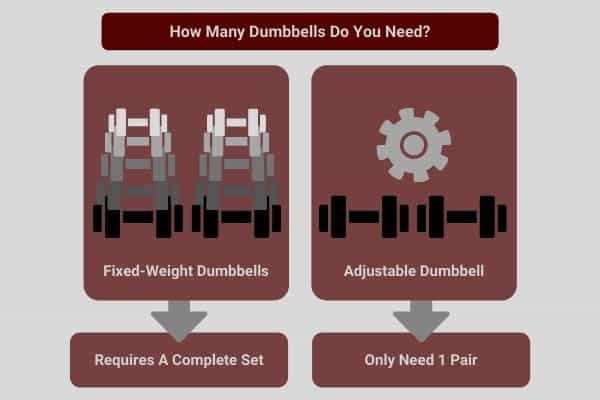
Fixed dumbbells have set weight. In order to access a range of weights, you’ll need multiple fixed dumbbells to form a complete set. And the poundage for each set can be tailored to your exact needs.
On the other hand, adjustable dumbbells have mechanisms that allow you to quickly change the poundage. And this means just one pair of adjustable dumbbells can cover your needs.
However, this assumes that your adjustable dumbbells are heavy enough for your goals. If you’re dumbbells are too light, you’ll need to upgrade in no time.
Next, I’ll explain how to choose the right dumbbell weight for your needs.
Find out how to build a home gym with dumbbells in my other article!
Building Muscle With One Dumbbell: Choose A Suitable Weight!
Adjustable dumbbells come in different poundages. Each dumbbell has a maximum and minimum poundage, bridged by incremental weight increases.
As a beginner, it can be difficult to decide how heavy a dumbbell to buy. So what’s a suitable dumbbell weight for you as a beginner?
| Dumbbell Weight (Per Dumbbell) | Progression Potential | Potential Muscle Gains | Approximate Price |
|---|---|---|---|
| 30 Pounds | 1 to 3 months | 1 to 5 pounds | $200-300.00 |
| 50 Pounds | 3 to 6 months | 5 to 10 pounds | $300-400.00 |
| 70 Pounds | 6 to 24+ months | 10 to 25 pounds | $400-500.00 |
| 90 Pounds | 2+ years | 25+ pounds | $500-600.00 |
The above table shows how long you can expect a certain dumbbell poundage to last you for. It also shows how much muscle you could gain as a beginner (someone who’s been training for less than 6 months).
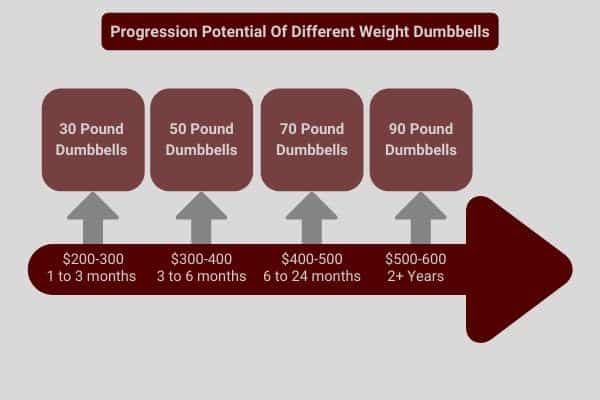
90 Pound Adjustable Dumbbells Are Future-Proof.
Ideally, you should buy a pair of 90 pound adjustable dumbbells.
Although they’re the most expensive (about US$500-600 for a pair), they can also be used for at least 2 years of regular training.
Keep in mind that 2 years of gym membership alone will often cost over $600.00.
90 pounders will also allow you to build around 25+ pounds of muscle, and that’s enough to transform a skinny body.
Therefore the premium price tag for these dumbbells give them a degree of longevity, and could also well end up saving you money from gym membership and having to upgrade unsuitable dumbbells.
Check out my other article for tips to gain muscle as a skinny guy!
70 Pound Adjustable Dumbbells Are Also Great.
If you would rather spend less money, 70 pound adjustable dumbbells are also be great for beginners.
They’re moderately priced (about US$400-500 for a pair), and their price tag is reflected in their reduced longevity.
70 pounders allow you to build a respectable 10 to 25 pounds of muscle, and can be used for up to 2 or more years.
Therefore these are great for those who want to improve their physique on a slightly lower budget.
50 Pound (Or Less) Adjustable Dumbbells Should Be Avoided.
There are many cheap 50 pound (and less) adjustable dumbbells on the market.
Although the initial price tag seems cheap, they aren’t great for anyone who intends to build any amount significant of muscle mass.
In fact, they provide very little muscle returns. And chances are, these dumbbells will need to be upgraded fairly quickly.
As such, I do not recommend them for anyone who is serious about transforming their body.
I would suggest getting a heavier poundage instead, allowing you to make-do with one pair of dumbbells that last you a long time, rather than needing to upgrade potentially multiple times.
Check out my other article to find out if home dumbbells are worth the money!
Can You Build Muscle With Dumbbells Alone?
So you’ve chosen the perfect dumbbell poundage. And you’re ready to make some serious muscle gains. But can you really build muscle with just a single pair of dumbbells?
You sure can!
Dumbbell exercises are an effective way to build muscle. They are a versatile type of free weight, allowing you to perform a variety of compound and isolation exercises that can engage all the major muscle groups in the body. But make sure you choose to lift heavy dumbbells.
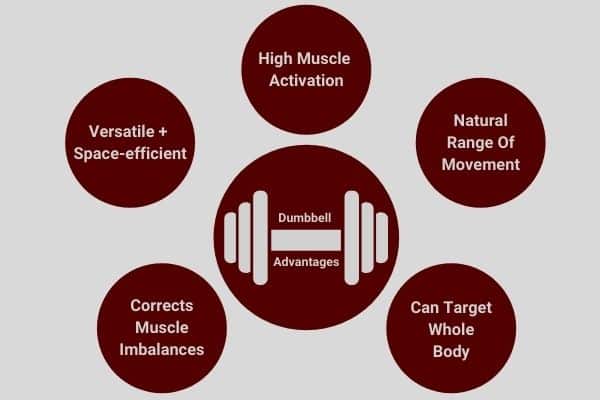
In fact, dumbbells are a favourite amongst bodybuilders, coaches, and beginners alike.
The key to building muscle at home with dumbbells is to know the right exercises to perform.
Jeff Cavalier, C.S.C.S coach at Athlean-X
So what can you do with a pair of dumbbells?
Here are the best dumbbell exercises to gain muscle:
| Dumbbell Chest Exercises | Dumbbell Shoulder Exercises | Dumbbell Arm Exercises | Dumbbell Abdominal Exercises | Dumbbell Back Exercises | Dumbbell Leg Exercises |
|---|---|---|---|---|---|
Bench press | Overhead press | Underhand-grip curl | Weighted sit-up | Overhand row | Deadlift |
| Incline bench press | Hammer press | Reverse-grip curl | Weighted sit-up | Underhand row | Squats |
| Floor press | Lateral raise | Hammer-grip curl | Leg raise | Single-arm row | Pistol squat |
| Chest Fly | Front raise | Tricep extension | Weighted V-up | T-bar row | Hamstring curl |
| Cross over | High pull | Tricep kickback | Wood chop | Reverse fly | Lunge |
| Pullover | External rotation | Narrow-grip press | Russian twist | Shrug. | Calf-raise |
By performing a variety of dumbbell exercises, at heavy weights, you will be able to gain muscle and develop a significantly more powerful physique!
Go to my other article for in-depth tutorial on how to perform these dumbbell exercises!
Choosing Between 1 Or 2 Dumbbells.
Most people buy 2 dumbbells, but that’s not to say that you HAVE to get a pair of dumbbells.
Some people choose to buy a 1 dumbbell and workout that way.
So should you buy 1 or 2 dumbbells?
It is generally recommended to work out with two dumbbells rather than one. Two dumbbells offer improved balance, increased weight-load, and decreased training times. This makes working out with two dumbbells more effective than working out with a single dumbbell.
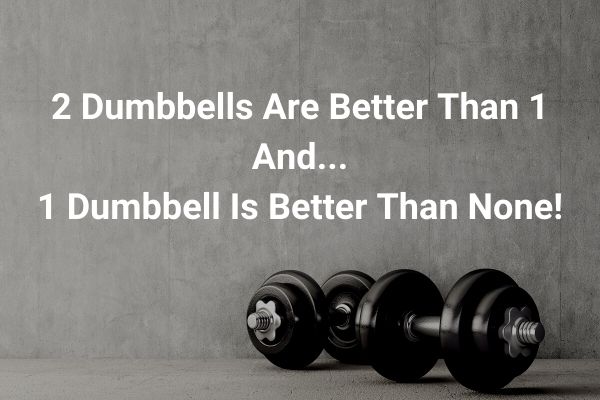
That being said, both forms of training CAN build muscle. As long as you’re lifting heavy and combining that with a caloric surplus, you will gain muscle.
Training with two dumbbells will yield better and faster muscle gain results.
However, if you only have access to one dumbbell, you need to remember that’s better than no dumbbell (or not working out at all).
This is what I’ll explore next.
What Is Unilateral And Bilateral Training?
To understand why two dumbbells are better than one, you need to understand what bilateral and unilateral exercises are.
Bilateral exercises involve both sides of the body pushing or pulling on a resistance. Examples include the dumbbell bench press and shoulder press. Unilateral exercises involve one side of the body pushing or pulling on a resistance. An example is the one-arm lateral raise and dumbbell lunge.
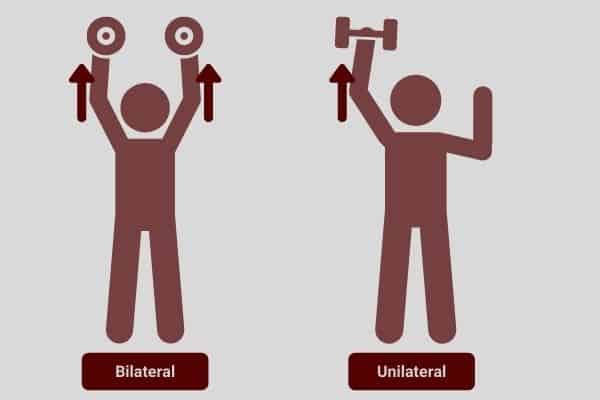
Most of the popular muscle-building exercises are bilateral, and they require two dumbbells (think of the dumbbell bench press).
However, if you only have access to one dumbbell, you will have to turn those bilateral exercises into unilateral ones! (think of the one-arm bench press).
So can unilateral exercises be as good as bilateral exercises to build muscle?
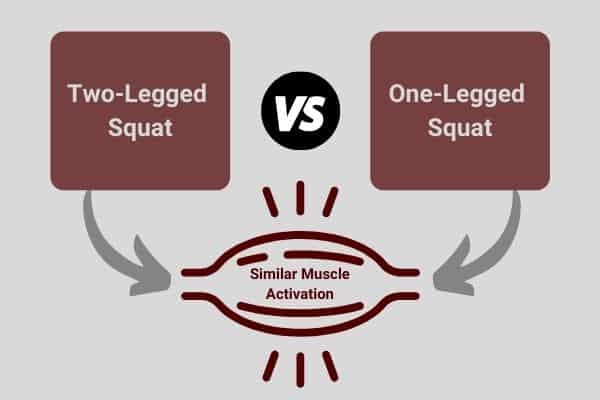
This 2012 study seems to suggest so.
Here, 10 men were asked to perform the dumbbell squat bilaterally and unilaterally. The muscle activity in the leg was then measured using electrodes.
And what did they find?
The leg muscles were activated to similar levels between the bilateral and unilateral dumbbell squat!
Therefore training with one dumbbell seems to be just as good as training with two dumbbells.
In accordance with this, another 2016 study agreed that unilateral and bilateral squatting produces similar leg strength increases.
Can You Really Build Muscle With Just 1 Dumbbell?
The science says you can build muscle with just one dumbbell. But what’s the public’s opinion?
To find out, I tracked down 3 Quora posts:
- What are the reasons to use 2 dumbbells rather than 1?
- Can I build muscle with only 1 dumbbell?
- Is it harder to use 1 dumbbell compared to 2?
I analysed all the responses to find out if people agree that 1 dumbbell can build muscle.
Here are the results:
| Yes | No | Yes, With Limitations |
|---|---|---|
| 40% | 15% | 45% |
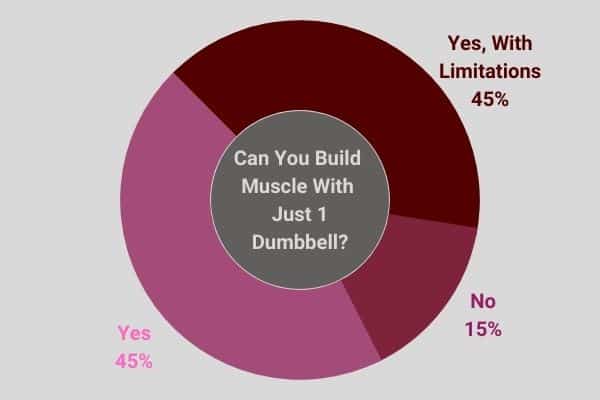
As you can see, the majority of people (85%) believe you CAN build muscle with just 1 dumbbell.
And almost half (45%) of those who said it was possible to build muscle with just 1 dumbbell, also noted that unilateral training has its disadvantages.
Next, I’ll explain the advantages and disadvantages of bilateral and unilateral training.
Read my other article to find out how to use dumbbells to gain muscle!
Unilateral Vs Bilateral Benefits Comparison.
If bilateral and unilateral exercises are as good as each other, does that mean you should just buy one dumbbell and save your money, rather than buying two?
Not quite.
That’s because bilateral and unilateral exercises have their unique benefits and drawbacks:
| Bilateral Benefits | Bilateral Drawbacks | Unilateral Benefits | Unilateral Drawbacks |
|---|---|---|---|
| Allows heavier weights to be lifted. | Daily movements are often unilateral | Activate stabilisers. | Limited weight. |
| Easier to execute. | May lead to muscle imbalance | Correct muscle imbalances. | Harder to execute. |
| Reduced injury risk. | Easier to “cheat” | Improved mind-muscle connection. | Increased injury risk. |
Training with two dumbbells (bilaterally) tends to be easier for beginners to lift more weight. This is because the weights are balanced on both sides and you don’t require as much stabilisation. Since bilateral exercises are easier to perform, this also reduces the risk of injury.
However, the increased stability of two dumbbells also makes it easier to sacrifice good form and instead “cheat” by using your body momentum to lift the dumbbells. This in turn may lead to muscle imbalances.
In contrast, training with one dumbbell (unilaterally) requires a lot of concentration and a good mind-muscle connection to lift a highly unbalanced dumbbell. As a result, you will develop balanced muscle gains.
However, lifting with one dumbbell is extremely difficult due to the imbalance. This makes it much harder to perform, limits the amount of weight you can lift, and increases the risk of injury.
Therefore as a whole, beginners are advised to start by using two dumbbells to perform bilateral exercises.
Is It Necessary To Have 2 Dumbbells?
You’re advised to use 2 dumbbells as a beginner. But are 2 dumbbells ESSENTIAL for a good workout?
Again, not quite.
I’ve already discussed some of the main benefits of using two dumbbells as a beginner.
But here’s another reason why you should consider using two dumbbells:
Time.
Take a look at the table below for an idea of how much time you can save by using two dumbbells (instead of one).
| Dumbbell Exercise | Weight Lifted | Time To Complete 8 reps | Perceived Difficulty |
|---|---|---|---|
| Bench press (bilateral) | 154 pounds | 32 seconds | Hard |
| One-arm bench press (unilateral) | 55 pounds | 66 seconds | Extremely hard |
| Bent-over row (bilateral) | 132 pounds | 32 seconds | Hard |
| One-arm row (unilateral) | 65 pounds | 66 seconds | Hard |
| Shoulder press (bilateral) | 88 pounds | 32 seconds | Hard |
| One-arm shoulder press (unilateral) | 44 pounds | 66 seconds | Extremely hard |
The chart shows how long it takes to complete 8 reps and the perceived difficulty, between using one and two dumbbells.
These results are from my own personal experiments as as someone who has been training regularly for 10 years.
From my personal experience, I save around 30 seconds for every set of 8 reps performed.
If you assume an average of 25 sets per workout, that’s 13 minutes saved per workout using 2 dumbbells.
If you also assume 4 training days per week, that’s 52 minutes saved per week!
Therefore, lifting with two dumbbells is not essential. But it will save you a lot of time, as well as being easier to perform.
What To Do If You Only Have 1 Dumbbell.
Two dumbbells are recommended, but if you find yourself stuck with only one dumbbell, don’t fear!
A lot of popular exercises can be done relatively stress-free with one dumbbell.
These include:
- Bicep curls.
- Tricep extensions.
- Weighted sit-ups.
- Dumbbell pullovers.
And here are 10 additional exercises to train your entire body with a single dumbbell:
1) Single-Arm Bench Press.
The single-arm bench press a great way to engage the chest and arm muscles, just like the regular bench press. But the movement is highly unbalanced, so start with a lighter weight and engage your core for stabilisation.
Additionally, you can also try laying on a floor rather than a bench. This allows you to spread your legs and non-lifting arm for increased stability.
Check out my other article for more dumbbell exercises for a bigger chest!
2) Single-Arm Chest Fly.
This is the single-arm variation of the chest fly, which engages your chest muscles.
Again, you can stabilise the single-arm chest fly by laying on the ground with your non-lifting limbs spread.
3) Single-Arm Crossover.
The single-arm crossover is an effective way to target the upper chest if you only have one dumbbell.
You can stabilise the movement by taking a wide stance with your feet. Further stabilisation can be achieved by bending your knees (almost into a squat position) to lower your centre of gravity.
4) Single-Arm Lateral And Front Raise.
Dumbbell raises are usually performed with two dumbbells, one in each hand. But you can also perform them with a single dumbbell.
Stability can be a major drawback with the single-arm variation of this exercise. But you can rectify this by holding onto a door handle and leaning in the opposite direction to counterbalance the dumbbell.
5) Dumbbell Snatch.
This is a great alternative to the deadlift (which requires two dumbbells for adequate poundage).
To perform the dumbbell snatch, you only require one dumbbell. But it’ll effectively work your entire body.
6) Single-Arm Row.
The single-arm row is a popular way to train the back with just one dumbbell.
You will want to plant non-lifting hand on a bench or chair. This allows you to shift your weight onto the planted hand, and provide stability in the movement.
7) Single-Arm Reverse fly.
The reverse fly is an awesome exercise to hit your back muscles. It can be performed with a single dumbbell.
But like many single-dumbbell exercises, balance can be an issue. So take a wide stance with your feet to form a solid base.
8) Single-Arm Shrug.
This is an effective way to work your upper back with just one dumbbell.
Since the dumbbell remains close to your torso, balance and stabilisation isn’t that big an issue with the single-arm dumbbell shrug.
9) Dumbbell Chair Step Up.
Having access to just one dumbbell means the weight is severely limited. And this can be an issue when performing lower body exercises such as the squat, which targets the large leg muscles (since these muscles require heavier weights to train).
A solution to this is the dumbbell chair step up. Since it works one leg at a time, you’re effectively doubling the weight of your dumbbell (relative to a two-legged squat).
10) Dumbbell Lunge.
The dumbbell lunge is another great lower body exercise which can be performed using just one dumbbell.
When combined with the dumbbell snatch, it can work your entire body just as effectively as a deadlift!
Be Creative When Using A Single Dumbbell!
Most exercises that are usually performed with two dumbbells, can actually be performed with one dumbbells.
But you have to find creative ways to stabilise the imbalance which results from using one dumbbell.
This often involves widening your stance or finding a way to counterbalance the dumbbell.
I’ve given you some examples, so be creative and devise other ways!
However you choose to do it, make sure you maintain good form. This will present a greater stimulus for your muscles to grow, and make up for the limitation of reduced dumbbell poundages.
Conclusion
Today, Ive explained how many dumbbells you need to build muscle.
If you’re using adjustable dumbbells, then you can get away with just a single dumbbell.
However, you’re highly recommended to get two.
Two dumbbells will provide you with the best weight lifting experience as a beginner. And this will translate into faster muscle gains overall.
Regardless of your choice, you will need to make sure the dumbbell(s) are heavy enough for your goals!
How many dumbbells are you using?
Let me know in the comments below!
Alternatively, download the FREE Kalibre Muscle Blueprint to find out EXACTLY how I transformed my skinny body as a skinny guy!
Thanks for reading guys!
Peace Out,
Kal
(Biochemistry BSc, Biomedical Sciences MSc, Ex-Skinny Guy)


